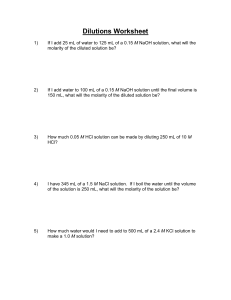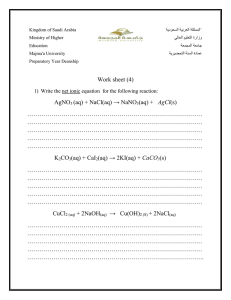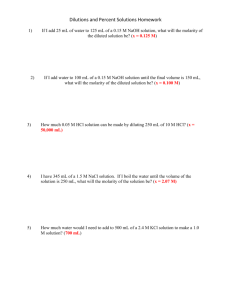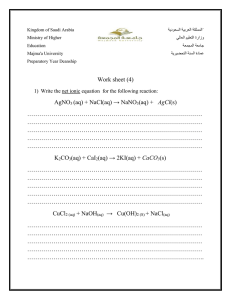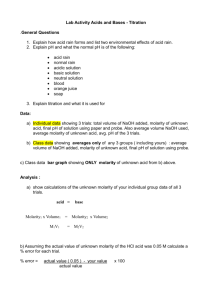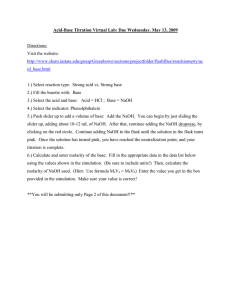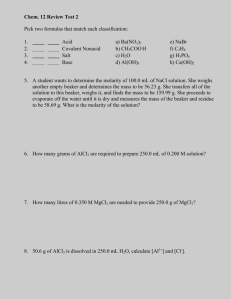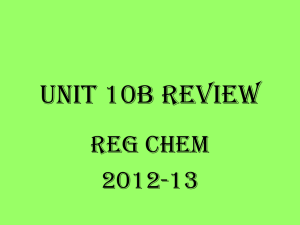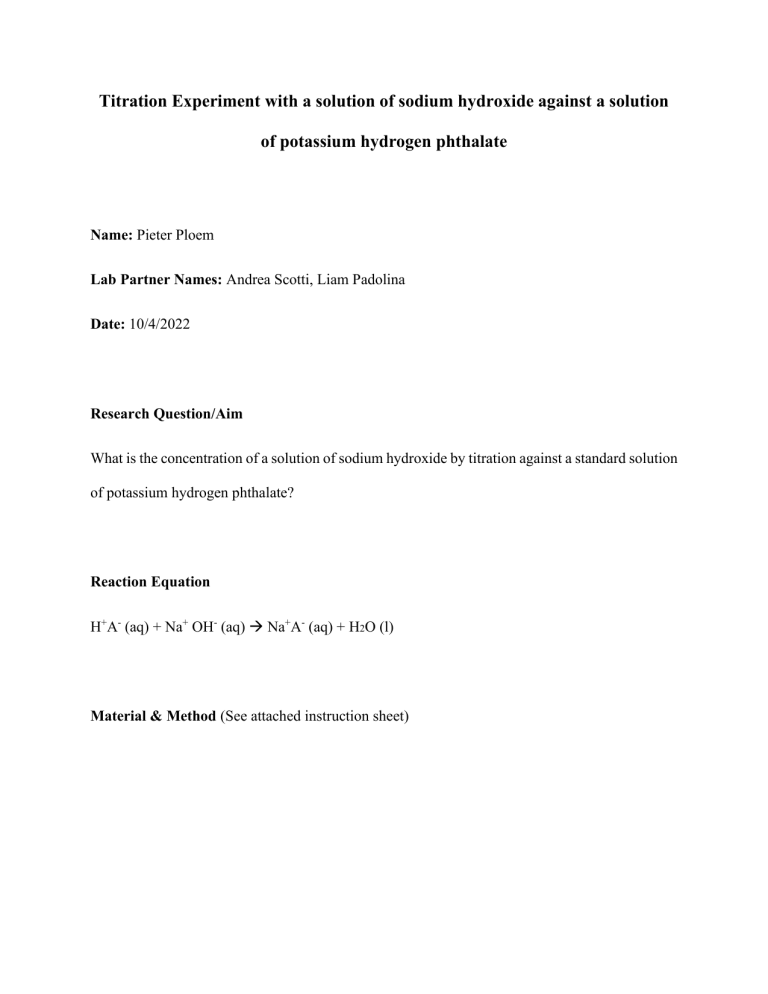
Titration Experiment with a solution of sodium hydroxide against a solution of potassium hydrogen phthalate Name: Pieter Ploem Lab Partner Names: Andrea Scotti, Liam Padolina Date: 10/4/2022 Research Question/Aim What is the concentration of a solution of sodium hydroxide by titration against a standard solution of potassium hydrogen phthalate? Reaction Equation H+A- (aq) + Na+ OH- (aq) → Na+A- (aq) + H2O (l) Material & Method (See attached instruction sheet) Raw Data (Quantitative) Table displaying used equipment for measurement and their uncertainties Weighing Scale (g) ± 0.01 Pipette Solution (cm3) ± 0.04 Burette Solution (cm3) ± 0.005 Volumetric Flask (cm3) ± 0.3 Eye Dropper Pipette (Drops) No uncertainty Table displaying the mass of Potassium Hydrogen Phthalate, the mass of the Weighing Bottle, and the mass of Potassium Hydrogen Phthalate + the mass of the Weighing Bottle Potassium Hydrogen Phthalate (g) 5.28 Weighing Bottle (g) 0.56 Potassium Hydrogen Phthalate + Weighing Bottle (g) 5.84 Table displaying the initial and final burette readings containing (NaOH) in a series of trials Trials Experimental 1 2 3 4 5 Trial Burette Final 24.45 49.00 24.35 48.20 23.80 47.65 Readings (cm3) Initial 0.00 24.45 0.10 24.35 0.00 23.80 Raw Data (Qualitative) + - Table displaying the extent to which the solution containing the products Na A (aq) + H2O (l) was pink-colored based on pure observation for a series of trials Trials Experimental 1 2 3 4 5 Pink Pink Very light Very light Very light pink pink pink Trial Extent of Bright Pink Pink Color Processed Data Table displaying the initial and final burette readings containing (NaOH) including the difference between the final and initial burette readings in a series of trials Trials Experimental 1 2 3 4 5 Trial Burette Final 24.45 49.00 24.35 48.20 23.80 47.65 Readings (cm3) Initial 0.00 24.45 0.10 24.35 0.00 23.80 Difference between 24.45 24.55 24.25 23.85 23.80 23.85 Final and Initial (cm3) Trials 3, 4, and 5 will be used for accurate evaluation for this experiment as the differences in these values vary the least amount in comparison to the other trials. Additionally to this, trials 3, 4, and 5 all displayed a very light pink color wherefore these trials were very close to the “end-point” where the reaction was just complete. Due to these factors, once could declare that these trials are hence the most accurate and reliable trials for evaluation. Table displaying the final and initial burette readings of NaOH, the difference between the final and initial burette readings of NaOH, and the mean value of the differences for trials 3, 4, and 5. Trials 3 4 5 Final 48.20 23.80 47.65 Readings (cm3) Initial 24.35 0.00 23.80 Difference between 23.85 23.80 23.85 Burette Final and Initial (cm3) Mean Value of the 23.83 Differences (cm3) With this data, the molarity of Sodium Hydroxide (NaOH) will be calculated Given - Mass of Potassium Hydrogen Phthalate – 5.28g - Volume of Potassium Hydrogen Phthalate used for reaction – 25 cm3 - Mean value for the volume of Sodium Hydroxide used for reaction – 23.83 cm3 - Balanced Chemical Equation – HA(aq) + Na+OH-(aq) →Na+A-(aq) + H2O(l) Unspecified/Unknown - Molarity of Potassium Hydrogen Phthalate - Exact Molarity of Sodium Hydroxide First, the Molarity of HA needs to be calculated. In order to do this, the number of moles in 5.28g of HA must be calculated. The molar mass of HA is 204.22 gmol-1. The calculations to get the number of moles can be seen in the following: 5.28𝑔 204.22𝑔/𝑚𝑜𝑙 ≈ 0.026 𝑚𝑜𝑙𝑠 Since this number of moles was applied to 250 cm3 or 0.250 dm3 of distilled water, we can determine the molarity of the HA solution. The calculations are seen in the following: 0.026 𝑚𝑜𝑙𝑠 0.250 𝐿 0.103𝑀 Now that the Molarity of HA is, determined, we can deduce the molarity of NaOH. Since only 25 cm3 of the 0.103M solution of HA was used in the reaction with the NaOH solution, we must calculate the number of moles of HA present in the 25 cm3 of 0.103M solution. The calculations can be seen in the following: 𝑛 = 0.103𝑀 0.025 𝐿 𝑛 = 𝑛𝑢𝑚𝑏𝑒𝑟 𝑜𝑓 𝑚𝑜𝑙𝑒𝑠 0.025 𝐿 ∗ 0.103𝑀 = 𝑛 𝑛 = 0.0026 𝑚𝑜𝑙𝑠 Due to the equation, we know that HA and NaOH have a one-to-one ratio, therefore this means that if HA has 0.0026 mols in a 25 cm3 solution, NaOH has 0.0026 moles in the calculated 23.83 cm3 solution. Knowing this, the molarity of NaOH will be calculated. 0.0026 𝑚𝑜𝑙𝑠 0.02383 𝐿 𝟎. 𝟏𝟎𝟖𝟓𝑴 Therefore, it can be concluded that the Molarity of the NaOH solution is 0.1085M or 0.1085 mol dm-1. The Uncertainty of the Molarity of NaOH In order to find the uncertainty of the molarity of NaOH, the measured values with their uncertainty that were included in the calculations that led to finding the value for the molarity of NaOH, need to be analyzed and evaluated. The first step in the calculation was to find the number of moles in 5.28g of HA which was done by dividing the mass of HA “5.28g” by the molar mass of HA. 5.28 grams has an uncertainty which can be calculated by adding the uncertainty of the recorded mass of HA + Weighing bottle (±0.01g) with the uncertainty of the recorded mass of the Weighing bottle (±0.01g). This can be calculated in this way since the mass of HA + Weighing bottle was subtracted by the mass of the Weighing bottle to find the mass of HA. When adding or subtracting variables of the same type of measurement (mass, length, etc.), we simply add the absolute uncertainties of these variables together. Therefore, the uncertainty of the mass of HA is ±0.02g. Using the uncertainty of the mass of 5.28g, we can find the percentage uncertainty of the number of moles in 5.28g of HA. This is shown in the following calculations: ( ∆𝑢 ) ∗ 100 𝑚 ∆𝑢 = 𝐴𝑏𝑠𝑜𝑙𝑢𝑡𝑒 𝑢𝑛𝑐𝑒𝑟𝑡𝑎𝑖𝑛𝑡𝑦 𝑚 = 𝐴𝑣𝑒𝑟𝑎𝑔𝑒 𝑚𝑒𝑎𝑠𝑢𝑟𝑒𝑚𝑒𝑛𝑡 0.02 ( ) ∗ 100 5.28 ≈ 𝟎. 𝟑𝟖% The next step in calculating the molarity of NaOH was to find the Molarity of HA. This was done by dividing the calculated number of moles in 5.28g of HA by 250 cm3 of distilled water solution. In order to find the uncertainty of the molarity of HA, the percentage uncertainty of the number of mols in 5.28g of HA needs to be added to the percentage uncertainty of the 250 cm3 volume since there variables are divided by each other. The 250 cm3 volume had an uncertainty of ±0.3 cm3 since this solution was measured in a volumetric flask with an uncertainty of ±0.3 cm3. The percentage uncertainty of the 250 cm3 volume is 0.12%. Since the same calculation process to find the percentage uncertainty was already shown above, the calculations for percentage uncertainties won’t be shown moving forward. The sum of the percentage uncertainty of the number of mols in 5.28g of HA and the volume of 250 cm3 is ±0.50%. Therefore, the percentage uncertainty of the molarity of the HA solution is ±0.50%. The next step in calculating the molarity of NaOH was to find the number of moles in a 25 cm3 HA solution with the calculated 0.103M. This was done by multiplying the molarity of the solution by 0.025 L. The volume of 25 cm3 has an uncertainty of ±0.04 cm3. In order to find the uncertainty of the number of moles in this solution, the percentage uncertainties of both the Molarity of the solution and the 25 cm3 must be added because they are multiplied by each other. The percentage uncertainty for the 25 cm3 volume is ±0.16%. The sum of the percentage uncertainty of the molarity of the HA solution and the percentage uncertainty of the 25 cm3 solution is approximately ±0.66%. Therefore, the percentage uncertainty of the number of moles in a 25 cm3 0.103M solution of HA is ±0.66%. The final step in calculating the molarity of NaOH was to divide the calculated number of mols in a 25 cm3 0.103M solution of HA by the average volume of NaOH needed to exactly and fully complete the reaction as this calculation would yield the precise molarity of NaOH. To find the final percentage uncertainty of the molarity of NaOH, the percentage uncertainty of the number of mols in a 25 cm3 0.103M solution of HA must be added to the percentage uncertainty of the average volume of NaOH needed to exactly complete the reaction since these measurements are being divided by one another. The uncertainty of the average volume of NaOH needed to exactly complete the reaction has an uncertainty that needs to be calculated since this value is an average. This average was taken from 3 different measurements of NaOH from the burette that has an uncertainty of ±0.005 cm3. To find the average, the three burette readings are added together and then divided by three. Since three measurements of the same absolute uncertainty were added together, the possibility of an uncertain value increases by three. Knowing this, the absolute uncertainty of the average volume of NaOH needed to exactly complete the reaction can be calculated by adding the absolute uncertainties of the three measurements together. This sum is ±0.015 cm3. The percentage uncertainty is then ±0.06%. The sum of both the percentage uncertainties of the average volume of NaOH needed to exactly complete the reaction and the calculated number of mols in a 25 cm3 0.103M solution of HA is ±0.72%. Therefore, the percentage uncertainty of the molarity of NaOH is ±0.72%. Finally, the absolute uncertainty of the molarity of NaOH is shown in the following calculation: ∆𝑢 = 𝑚 ∗ 𝐹𝑢 𝐹𝑢 = 𝐹𝑟𝑎𝑐𝑡𝑖𝑜𝑛𝑎𝑙 𝑢𝑛𝑐𝑒𝑟𝑡𝑎𝑖𝑛𝑡𝑦 ∆𝑢 = 0.1085 ∗ 0.0072 ±𝟎. 𝟎𝟎𝟎𝟕𝟖𝑴 The molarity of NaOH with its absolute uncertainty is 0.1085M ±0.00078M. Evaluation For this experiment, the aim was to answer the research question “What is the concentration of a solution of sodium hydroxide by titration against a standard solution of potassium hydrogen phthalate?”. By following the procedure of this experiment, I was able to deduce a quite accurate value for the molarity of a NaOH solution. This value being 0.1085M ±0.00078M. The degree to which this value is accurate can be statisticized when comparing my value for the molarity of NaOH (0.1085M) with the accepted value for the molarity of NaOH (0.1038M) in the form of the percent error. The calculations needed to find the percent error are the following: 𝑃𝑒𝑟𝑐𝑒𝑛𝑡 𝐸𝑟𝑟𝑜𝑟 = | 0.1085𝑀 − 0.1038𝑀 | ∗ 100 0.1038𝑀 𝑃𝑒𝑟𝑐𝑒𝑛𝑡 𝐸𝑟𝑟𝑜𝑟 = 4.53% 4.53% is a low percent error, especially for an experiment that requires many steps and requires multiple measurements, hence greater uncertainties. The reason why the value for molarity is quite accurate is due to a few factors. The first factor was the great success I had achieved when gathering data. There were no severe incidents, other than one small incident, that would disrupt the experiment drastically and hence affect the credibility of the data. I also made sure to do multiple trials and select three very good pieces of data that had similar values and very light pink solutions containing the products of the reaction. The very light pink solution helped verify that the end-point was just reached and not bypassed significantly, thus once again adding to the credibility of the data. I also made sure to gather all the data on the same day hence reducing the potential random and systematic errors caused due to the changes in the surrounding environment. However, there were certain factors that potentially negatively did affect the accuracy of the resulting value. One of the factors is that we had different group members verify the measurements. This occurred most frequently when observing the readings from the burette wherefore the way we read and note down the measurements varied each time as it was based on the personal judgment of multiple people. As mentioned previously, there was a small incident that likely affected the final value for the molarity of NaOH. This was when my group members and I had collected the HA in the weighing bottle and had already done the measuring of its mass. The weighing bottle was placed down a bit too aggressively on the table where small amounts of HA fell out of the container. We had tried to the best of our ability to put back the escaped bits of HA back into the weighing bottle; however, it is almost certain that there were minute amounts still lost. Due to this, the mass of the HA was to a certain extent reduced, which reduces the number of moles in HA, which reduces the molarity of the HA solution and thus also reduces the molarity of the NaOH solution. This is a valid incident to reflect on, even though it is still quite small, since my final value for the molarity of NaOH was over the accepted value and if I had avoided this incident, the molarity of NaOH would have been reduced and potentially closer to the accepted value. In general, the method and procedure were quite effective and reliable for gathering accurate data. The method’s strong points are its choice of measuring devices as the great majority of the measuring devices were capable of presenting very accurate measurements, especially the 25 cm3 pipette. The method also allowed for very efficient data gathering once everything was prepared. However, the main methodological issues that I encountered were its lack of explanation for disposing of the chemicals after the experiment was completed. The method doesn’t specifically clarify that the solution with the products should be put away into a waste beaker. Additionally, to this, it doesn’t clarify if the chemicals can be poured down the sink, or whether they need to be disposed of through the EHS hazardous waste program. Next time the procedure should provide an MSDS to clarify hazards more clearly to reduce the risk of injury. To extend this investigation, we could observe the effects of changing the temperature of the NaOH solution on how it affects the calculated molarity of NaOH through titration. According to Vedantu.com, a highly rated live online tutoring company, “When temperature increases the volume of the solution also increases and this reduces the molarity of the substance” (“What Is the Effect of Temperature on Molarity Class 12 Chemistry CBSE”). This would extend my knowledge and my understanding of the different factors that affect molarity and how to improve my ability of being able to apply titration to find different molarities. Works Cited “What Is the Effect of Temperature on Molarity Class 12 Chemistry CBSE.” Vedantu.com, 6 July 2021, www.vedantu.com/question-answer/effect-of-temperature-on-molarity-class12-chemistry-cbse-60e51bbb22400a17eb302a9e.
